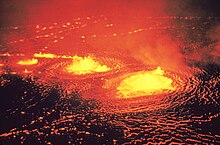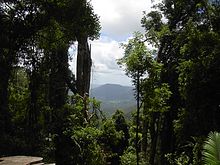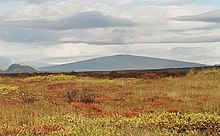A caldera is a large cauldron-like hollow that forms shortly after the emptying of a magma chamber in a volcano eruption. An eruption that ejects large volumes of magma over a short period of time can cause significant detriment to the structural integrity of such a chamber, greatly diminishing its capacity to support its own roof, and any substrate or rock resting above. The ground surface then collapses into the emptied or partially emptied magma chamber, leaving a large depression at the surface. Although sometimes described as a crater, the feature is actually a type of sinkhole, as it is formed through subsidence and collapse rather than an explosion or impact. Compared to the thousands of volcanic eruptions that occur over the course of a century, the formation of a caldera is a rare event, occurring only a few times within a given window of 100 years. Only seven caldera-forming collapses are known to have occurred between 1911 and 2016. More recently, a caldera collapse occurred at Kīlauea, Hawaii in 2018.

A volcano is a rupture in the crust of a planetary-mass object, such as Earth, that allows hot lava, volcanic ash, and gases to escape from a magma chamber below the surface.

A shield volcano is a type of volcano named for its low profile, resembling a shield lying on the ground. It is formed by the eruption of highly fluid lava, which travels farther and forms thinner flows than the more viscous lava erupted from a stratovolcano. Repeated eruptions result in the steady accumulation of broad sheets of lava, building up the shield volcano's distinctive form.

An active volcano is a volcano that has erupted during the Holocene, is currently erupting, or has the potential to erupt in the future. A volcano that is not currently erupting but could erupt in the future is known as a dormant volcano. Volcanoes that will not erupt again are known as extinct volcanoes.
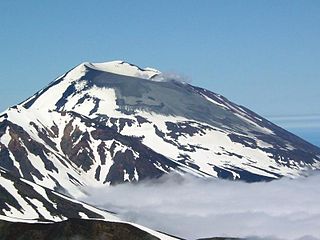
Korovin Volcano is one of four volcanic centers of the Atka Volcanic Complex, located near the town of Atka on the northeast part of Atka Island in the Aleutian Islands chain, Alaska, United States. At 5,030 feet (1,530 m), Korovin is the highest point on the island.
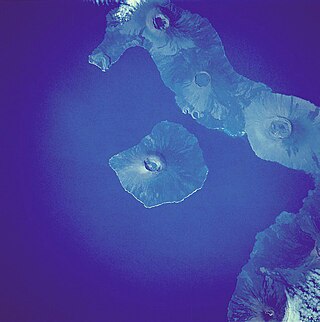
Fernandina Island is the youngest and third largest island in the Galapagos, as well as the furthest west. It has an area of 642 km2 (248 sq mi) and a height of 1,476 m (4,843 ft), with a summit caldera about 6.5 km (4.0 mi) wide. It is younger than Isabela, being only less than one million years old since its formation. Like the other islands, it was formed by the Galápagos hotspot. The island is an active shield volcano that has most recently erupted in March 2024.

Lava lakes are large volumes of molten lava, usually basaltic, contained in a volcanic vent, crater, or broad depression. The term is used to describe both lava lakes that are wholly or partly molten and those that are solidified.
Marchena Island is one of the Galapagos Islands in Ecuador. It has an area of 130 square kilometers (50 sq mi) and reaches an elevation of 343 meters (1,125 ft) above sea level. The island does not receive visitors, although the surrounding water is used by aquatic divers on organized tours. People generally see the island as they sail around the northern part of Isabela on the way to Genovesa Island.

Cerro Azul is a shield volcano on the south western part of Isabela Island in the Galápagos Islands. At a height of 1,689 m (5,541 ft) it is the second highest peak in the Galapagos and due to its topographic prominence of over 1,500 m (4,921 ft) it is categorised as an ultra. The volcano is one of the most active in the Galapagos, with the last eruption between May and June 2008.

MenengaiCrater is a massive shield volcano with one of the biggest calderas in the world, in the Great Rift Valley, Kenya. It is the largest volcano caldera in Kenya and the second largest volcano caldera in Africa. Volcanic formed rich loam soils enrich the adjacent farmland around its flanks. The crater is on the floor of the Rift Valley. The volcano formed about 200,000 years ago and the prominent 12 x 8 km caldera formed about 8000 years ago. The caldera floor is covered with numerous post caldera lava flows. The Menengai volcano is considered one of the best-preserved Krakatau-style calderas in the world. Menengai has very little sediment in the caldera which is a thick mass of lava boulders and inaccessible ridges. Volcanic activity continues and a current project under the GDC is at an advanced stage towards geothermal power generation.

Namarunu is a shield volcano located in the Great Rift Valley, Kenya.

Erta Ale is a continuously active basaltic shield volcano in the Afar Region of northeastern Ethiopia, which is itself part of the wider Afar Triangle. The volcano is located in the Danakil Depression, an area on the border between Ethiopia and Eritrea that is below sea level. It is the most active of the volcanoes in Ethiopia.

The Squaw Ridge Lava field, also known as the East Lava Field, is a young basaltic field located in the U.S. state of Oregon southeast of Newberry Volcano. The flow erupted from the Lava Mountain shield and is likely related to the Four Craters Lava Field, both of which were created after Mount Mazama erupted.

Taveuni is elongated shield volcano on Taveuni Island, Fiji, and its peak reaches 1,241 meters above sea level.
Calabozos is a Holocene caldera in central Chile's Maule Region. Part of the Chilean Andes' volcanic segment, it is considered a member of the Southern Volcanic Zone (SVZ), one of the three distinct volcanic belts of South America. This most active section of the Andes runs along central Chile's western edge, and includes more than 70 of Chile's stratovolcanoes and volcanic fields. Calabozos lies in an extremely remote area of poorly glaciated mountains.

Volcán Ecuador is the smallest of six shield volcanoes comprising Isabela Island of the Galápagos with an elevation of 790 m (2,590 ft). It contains a caldera that is breached to the west by edifice collapse. The caldera floor is largely covered by youthful lava flows and contains several chains of spatter cones and small scoria cones.

The Galápagos Islands are an isolated set of volcanoes, consisting of shield volcanoes and lava plateaus, located 1,200 km (746 mi) west of Ecuador. They are driven by the Galápagos hotspot, and are between 4.2 million and 700,000 years of age. The largest island, Isabela, consists of six coalesced shield volcanoes, each delineated by a large summit caldera. Española, the oldest island, and Fernandina, the youngest, are also shield volcanoes, as are most of the other islands in the chain. The Galápagos Islands are perched on a large lava plateau known as the Galápagos Platform, which creates a shallow-water depth of 360 to 900 m at the base of the islands, which stretch over a 174 mi (280 km)-long diameter. Since Charles Darwin's famous visit to the islands in 1835, over 60 recorded eruptions have occurred in the islands, from six different shield volcanoes. Of the 21 emergent volcanoes, 13 are considered active.
